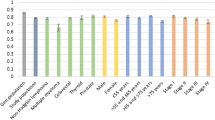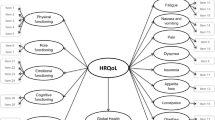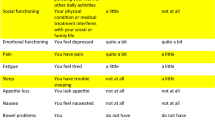Abstract
In cohort studies or clinical trials, measurements of quality of life (QoL) were averaged across available individuals for each group at given points in time to produce single measures for comparisons. However, estimates of these single measures may be severely biased if substantial mortality occurs over time. The objective of this study is to develop a method that integrates QoL measurement and survival for long-term evaluation of health services. We defined a mean QoL score function over time for an index population as the average QoL score of all individuals both alive and dead at each time point in the population. While a living subject's QoL can be assessed by asking one's subjective preference, the score of a decedent can be assigned a fixed value depending on the specific facet on health profile. The mean QoL score function over time is reduced to a single measure of expected cumulative QoL score, which is the area under the curve of mean QoL score function over a given time interval and can be estimated by taking a random sample from a cross-sectional survey. For the QoL score function to be extrapolated to life-long, it requires the assumption that the disease causes premature death or a long-term moderate impairment of QoL. We provided methods and computer programs for estimating mean QoL score functions and the reduced single measures for use in comparisons. A cohort of 779 breast cancer patients from Chiangmai, Thailand were followed for 12 years to demonstrate the proposed methods. The data included the 12-year complete survival records and QoL scores on 233 patients collected from a cross-sectional survey using WHOQOL questionnaire and standard gamble method. The expected cumulative QoL scores using utility and psychometric scales were compared among patients in four groups of clinical stages in this cohort for time from onset up to 12 years and life-long. We conclude that such an integration of QoL measurement with survival can be useful for the evaluation of health service and clinical decision.
Similar content being viewed by others
References
Berzon RA. Understanding and using health-related quality of life instruments within clinical research studies. In: Staquet MJ, Hays RD, Fayers PM (eds), Quality of Life Assessment in Clinical Trials: Methods and Practice. New York: Oxford University Press; 1998, 3-15.
The WHOQOL Group. The World Health Organization Quality of Life assessment (WHOQOL): Position paper from the World Health Organization. Soc Sci Med 1995; 41: 1403-1409.
Tengs TO, Wallace A. One thousand health-related quality of life estimates. Med Care 2000; 38(6): 583-637.
Bowing A. Measuring Disease. Buckingham: Open University Press, 1995.
McDowell I, Newell C. Measuring Health: A Guide to Rating Scales and Questionnaires. New York: Oxford University Press, 1996.
Drummond MF, O'Brien B, Stoddart GL, Torrance GW. Methods for the Economic Evaluation of Health Care Programmes. 2nd ed. New York: Oxford University Press, 1997.
Gold MR, Siegel JE, Russel LB, Weinstein MC. Cost-Effectiveness in Health and Medicine. New York: Oxford University Press, 1996.
Patrick DL, Ericson P. Health Status and Health Policy: Allocating Resources to Health Care. New York: Oxford University Press, 1993.
Kaplan RM. Profile versus utility based measures of outcome for clinical trials. In: Staquet MJ, Hays RD, Fayers PM (eds), Quality of Life Assessment in Clinical Trials: Methods and Practice. New York: Oxford University Press, 1998; 69-90.
Fairclough D. Methods of analysis for longitudinal studies of health-related quality of life. In: Staquet MJ, Hays RD, Fayers PM (eds), Quality of Life Assessment in Clinical Trials: Methods and Practice. New York: Oxford University Press, 1998; 227-247.
Hays RD, Alonso J, Coons SJ. Possibilities summarizing health-related quality of life when using a profile instrument. In: Staquet MJ, Hays RD, Fayers PM (eds), Quality of Life Assessment in Clinical Trials: Methods and Practice. New York: Oxford University Press, 1998; 143-153.
Hwang JS, Tsauo JY, Wang JD. Estimation of expected quality-adjusted survival by cross-sectional survey. Stat Med 1996; 15: 93-102.
Hwang JS, Wang JD. Monte Carlo estimation of extrapolation of quality-adjusted survival for follow-up studies. Stat Med 1999; 18: 1627-1640.
Chantawong C. Estimation of quality-adjusted survival of breast cancer patients in Chiangmai, Thailand. (Ph.D. dissertation) Bangkok. Thailand: Mahidol University Faculty of Public Health, 1997.
Efron B, Tibshirani RJ. An Introduction to the Bootstrap. New York: Chapman and Hall, 1993.
MC-QAS software for estimating expected quality-adjusted survival time adjusted for psychometric scores and utilities for health related quality of life assessment. Available from URL: http://www.stat.sinica.edu.tw/jshwang.
Martin NC, Sriskho S, eds. Statistical Report of the Registry Unit, Chiangmai. Thailand: Faculty of Medicine, Chiangmai University, 1993, 16 p.
The WHOQOL Group: Development of the World Health Organization WHOQOL-BREF quality of life assessment. Psychol Med 1998; 28: 551-558.
Cox DR, Fitzpatrick R, Fletcher AE, Gore SM, Spiegelhalter DJ, Jones DR. Quality-of-life assessment: Can we keep it simple? J R Stat Soc A 1992; 155: 353-393.
Schwartz CE, Laitin EA. Using decision theory in clinical research: Applications of quality-adjusted life-years. In: Staquet MJ, Hays RD, Fayers PM (eds), Quality of Life Assessment in Clinical Trials: Methods and Practice. New York: Oxford University Press, 1998; 119-141.
Wang JD. Basic Principles and Practical Application of Epidemiological Research. Singapore: World Scientific, 2002; 161-195.
Author information
Authors and Affiliations
Rights and permissions
About this article
Cite this article
Hwang, JS., Wang, JD. Integrating health profile with survival for quality of life assessment. Qual Life Res 13, 1–10 (2004). https://doi.org/10.1023/B:QURE.0000015299.45623.38
Issue Date:
DOI: https://doi.org/10.1023/B:QURE.0000015299.45623.38




